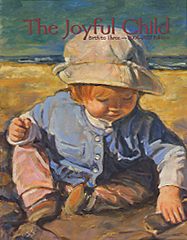
One of my dear roommates from Texas introduced me to Maria Montessori’s philosophy of childhood and education four years ago, and I have been entranced. Montessori joins St. Therese of Lisieux in proclaiming the readiness of very young children’s souls for a deep spirituality. There is a Catholic program, Catechesis of the Good Shepherd, which provides curricula for children from preschool age through twelve years old. It is only because this program is so remarkably sound that I want to take issue with their introduction of the Last Supper to preschoolers.
In a Montessori classroom, there are quite a few projects which the children are introduced to over time, and which they can then go to whenever they wish. These projects are called Works. The Last Supper Work is a diorama with a long table, eleven little men and one little figure for Jesus, a paten, a chalice and two candles. The child goes to the work station, takes the objects out of their box and arranges them the way he has previously been shown. Children of that age delight in rituals and doing things the exact same way every time, and there are just enough details to capture their attention. In the end the little scene looks quite a bit like the Altar Work (where they get to set up a little altar as though getting ready for Mass.) If I remember correctly, the candles are even lit at the end. Then when the child is ready to move on, he puts the objects away and goes to another work.
Now the problem here is that there are only eleven disciples rather than twelve. The thinking behind the omission is that preschool children are really too young to wrestle with the problem of evil and free will, so Judas is left out of the Last Supper work. If a child asks why there are only eleven, the teacher is supposed to tell them, “Judas left earlier.” The problem here is that it is not necessarily the case. The Last Supper sequence in John’s Gospel doesn’t line up exactly with the synoptic Gospels, but at one point Judas is given bread by Jesus: “So when he had dipped the morsel, he gave it to Judas, the son of Simon Iscariot. Then after the morsel, Satan entered into him.” (John 13:26-7). These are fundamental verses for understanding what it is to be loved by Christ—he always offers himself to us, but it is actually better for us to receive the devil if we want to than to be forced to receive Christ. Love resides in the will and yearns for the will of the beloved, and cannot accept anything less. Love is the most profound respect possible.
It seems to me that a preschooler is more likely to notice that there are only eleven disciples when other works have twelve than that a child would see the twelve and think “Wait a second—how can Judas be there if he betrayed Jesus?” And either way it seems like it would be infrequent, while every single child that does this work is having his imagination formed. Even if they don’t remember this particular bit of preschool, they will retain a strong impression that there were only eleven disciples at the Last Supper, which will make it harder for them to understand the reality of evil and free will when they get around to tackling it—and the grandeur of Love will be diminished in their imaginations.
